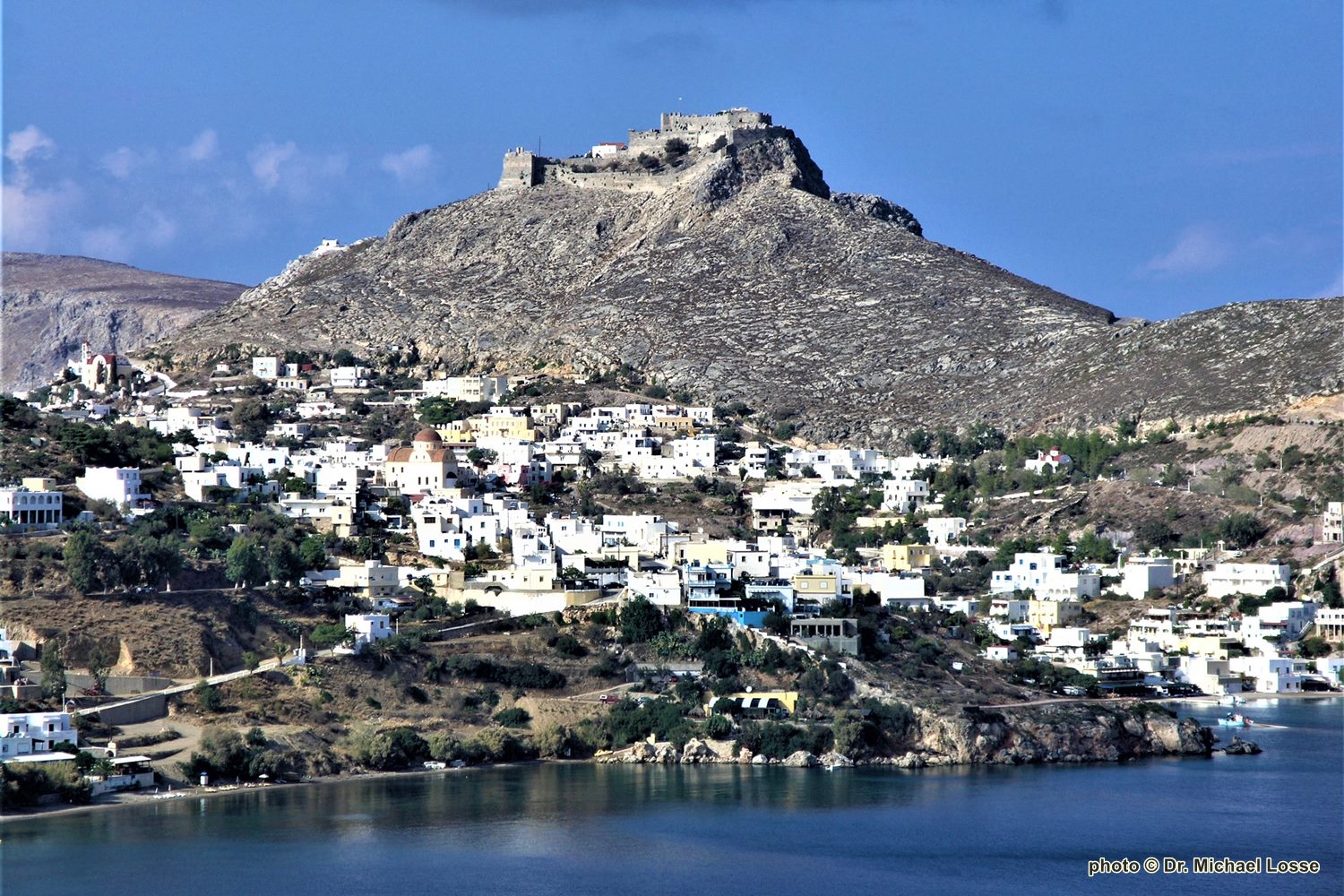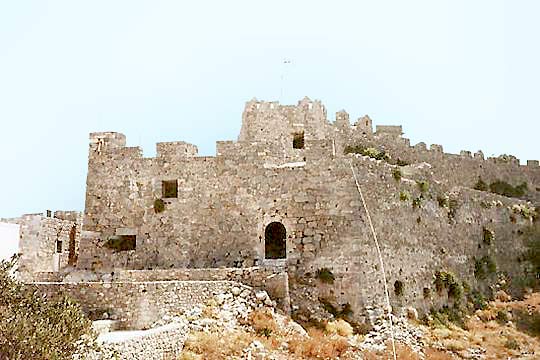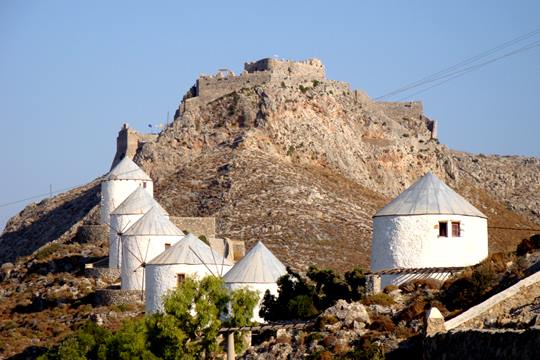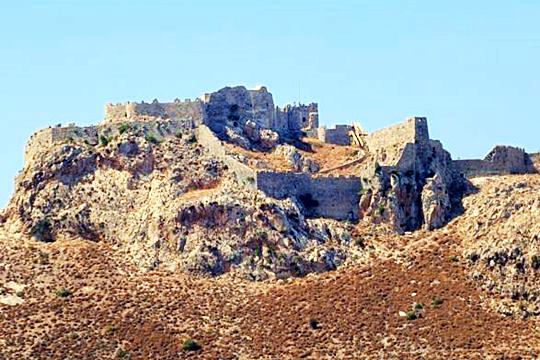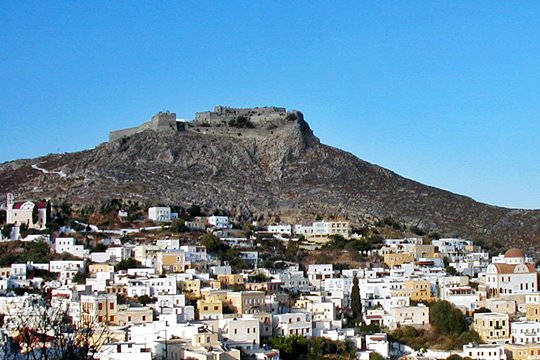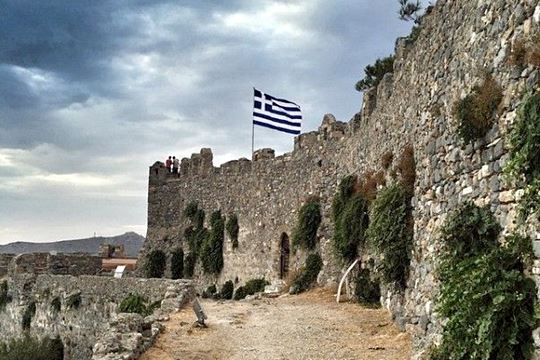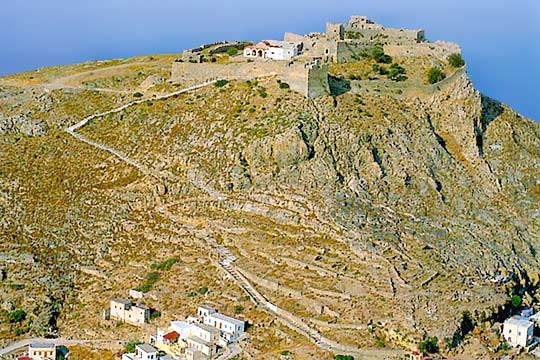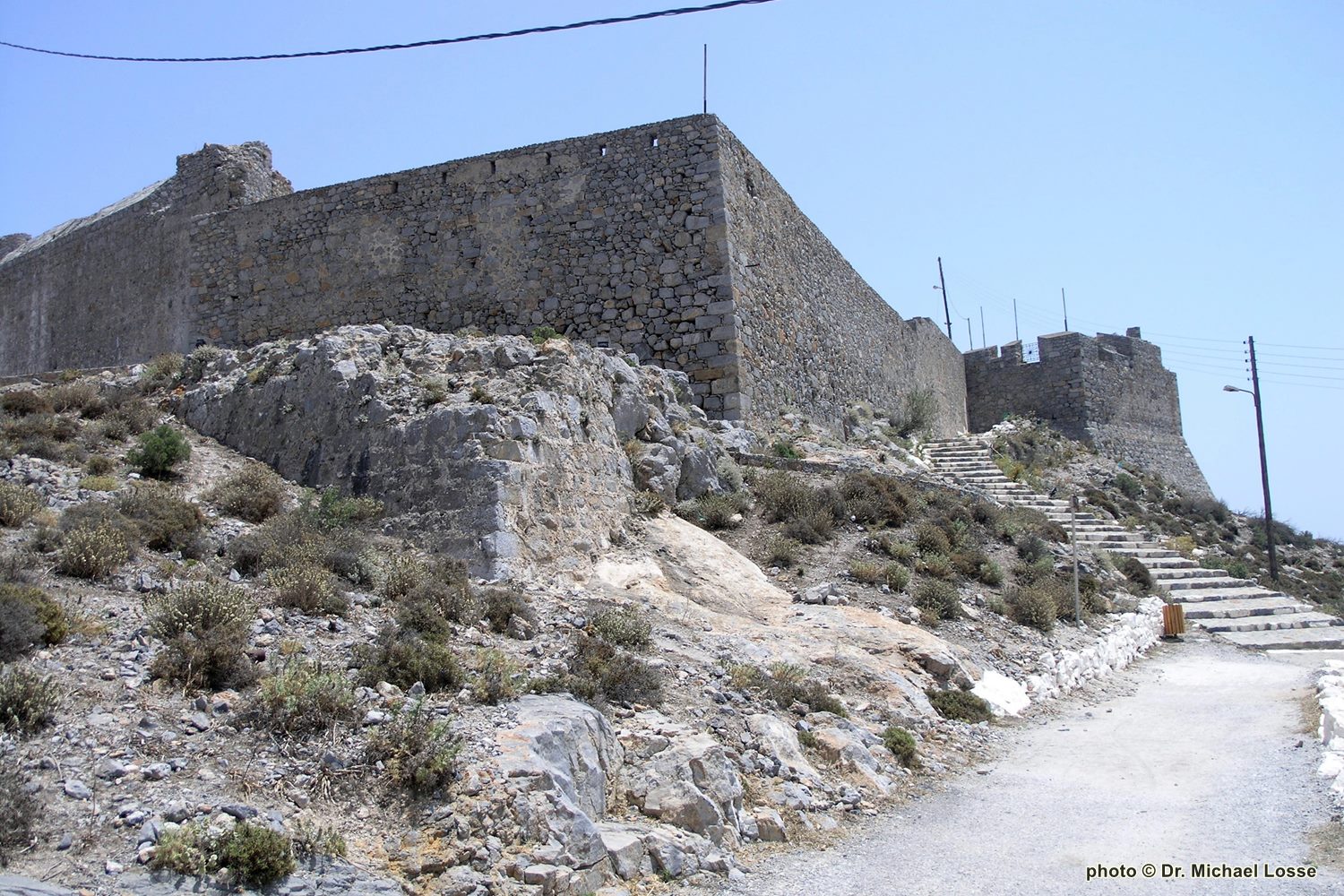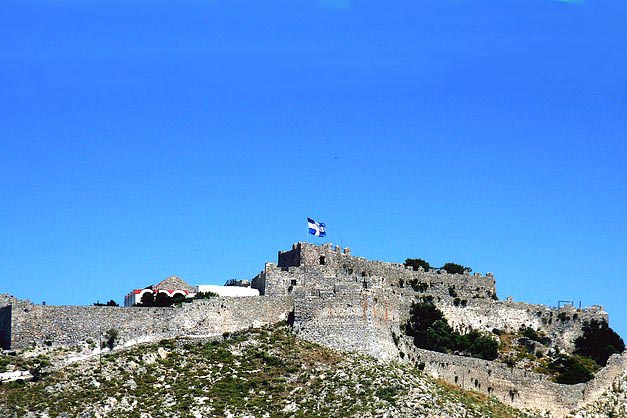Agia Marina, Leros, Dodecanese,South Aegean
Castle of Leros
| Location: |
| Agia Marina, Leros island |
| Region > Prefecture: | 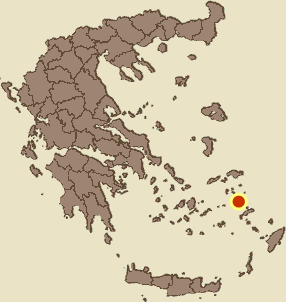 |
| South Aegean Dodecanese | |
| Municipality > Town: | |
| City of Leros • Agia Marina | |
| Altitude: | |
| Elevation ≈ 154 m |
| Time of Construction | Origin | |
| 11th century | BYZANTINE |
|
| Castle Type | Condition | |
| Island Citadel |
Average
|
Late medieval fortification/early bastionated (*) fortress as an extension of a Byzantine castle on the site of an ancient acropolis.
(*) The Knights Hospitallers are said to be among the first military powers who introduced bastionated fortifications. This happened in their Aegean state in the late 15th and early 16th centuries.
A bastion is a work projecting outwards from the main wall of a defensive enceinte of a castle, fortress, fortified town e.g., designed to enable the defense of the adjacent perimeter together with the area in front of the ramparts with firearms respectively artillery. Nowadays the word bastion in modern German definition is used for pentagonal works only, composed of two faces, two flanks and a gorge, and that’s, how the word will be used in the following text (Definition see: Michael Losse: Bastion. In: Reclam – Wörterbuch der Burgen, Schlösser und Festungen, ed. by Horst Wolfgang Böhme/Reinhard Friedrich/Barbara Schock-Werner in Connection with Europäisches Burgeninstitut der Deutschen Burgenvereinigung. Stuttgart 2004, p. 74-75). In former times and in other languages also other polygonal and cylindrical or semicircular works were respectively are called bastions.
Castle Description
Text: Dr. Michael Losse – Singen (Hohentwiel), Germany (16.05.2021)Location
The castle is situated on Pitýki Mountain, a steep promontory which is only 154 m in height, but “commands” the two most important harbours on the island, the bays of Álinda and Ajía Marína. As a lookout-post it was connected to different other castles and Vígles (which are mostly non fortified lookout-posts) on the Island of Kálymnos which belonged to the Knights Hospitallers.
Castle type
Early bastionated fortress as an extension of a Byzantine castle on the site of an ancient acropolis.
Condition
Ruin with extensively preserved components
General Description
Nowadays the castle is commonly named Kástro tís Panajías, meaning “Castle of St. Mary”. Other names are/were Phrourio[n], an old Greek word meaning castle or fortification; Toreo (cf. Spiteri 1994, p. 198; Vincentio Coronelli/Parisotti: Isola di Rodi geografico storico, antica e moderna coll’altre adiacenti già possedute da Caualieri Hospitalieri di S. Giovanni di Gerusalemme. Vol. I, Venice 1688, p. 349); Kástro toú Pandelioú, because it is situated close to Panteli Bay; Castello di Santa Maria as a re-use of the castle’s old name during the Italian occupation 1912-43.
The Kástro tís Panajías was the most important of the medieval castles and strongholds on the island of Léros: this most strategically sited fortification, which crowns the top of Mt. Pitýki between Plátanos, Ajía Marína and Álinda, commanded the two most important ports of the island, Álinda Bay and Ajía Marína bay. It consists of three enceintes.
The innermost enceinte, irregularly surmounting the highest part of Mt. Pitýki, is the oldest one and was built before the Hospitallers' rule, which means, by the Byzantines (Spiteri 1994; Spiteri 2001; Stefanidou 2002, p. 252). It is far away from being rectangular or “roughly-rectangular” as mentioned by different authors: the enclosure wall traces the configuration of the mountaintop. There are no towers, and only on the west side there is a dent in the line of the wall which enabled some form of enfilading defence. Inside this enceinte the ward was fitted with a couple of buildings, some of which were vaulted, resting against the walls (Spiteri 2001, p. 200). All those buildings were restored during the last years after the Greek army had left the Kástro.
Herein one could find escutcheons with the coat-of-arms of Fantino Querini, governor of the island of Kos till 1435, and an escutcheon bearing the arms of either Grandmaster Antoine de Fluvian (ruled 1421-37) or Grandmaster Jean Bonpart de Lastic (ruled 1437-54) (Gerola II 1916, p. 63). Both coats of arms differed only in colour, and the colour is lost.
A small gateway opens onto the southern part of the curtain wall, while another door (a postern blocked-up in the 20th century) is situated on the northern section of the enceinte. Another escutcheon bearing the arms of Fantino Querini was affixed to the outer face of the northern section of the curtain wall to the inner castrum. The curtain wall is built of irregular masonry of chalk and with fragments of antique marble workpieces. Only few parts of the enceinte reveal courses of large ashlar blocks of ancient origin but these do not appear to be in situ (Spiteri 2001, pp. 200-201).
Written sources and documents make clear that the Kástro, at the end of the 11th century, had two enceintes (Stefanidou 2002, p. 252), so the second enclosure wall was also built under Byzantine rule. Like the inner enclosure wall the second one is irregular. It follows the line of the inner one except for the north-western stretch, which follows the configuration of the mountain. This section of the curtain wall descends considerably downwards along one edge of the mountain.
The main entrance into the second ward is located on the south salient. This comparatively small door retains two protruding slabs fitted with pivoting sockets for a drawbridge. The entrance hall is covered by a narrow barrel-vault. A small door set on the left side of the passage leads to a vaulted room. Both the inner and outer wards have parapets with rectangular merlons, topped with triangular forms, which Gerola (1916) believed to be later Turkish additions.
The third defensive wall, which is the bastionated one, is not really an enclosure wall or enceinte, because it surrounds only three-fourths of the site and is connected to the second enceinte at it’s north-east and north-west, since to the north, the mountain was considered sufficiently inaccessible. On parts of the other fronts, however, the ground fell in a gradual slope and could more easily be assaulted. Especially this part of the castle has suffered considerable damage by time and important parts of it disappeared. As the best preserved section one can find the long stretch of curtain wall bearing the arms of Grand Master Emery d’Amboise (ruled 1505-12), “inscribed with the date 1509, and surmounting that of an unidentified knight dated 1511” (Spiteri 2001, p. 202).
It is known that in the year 1492 considerable works of strengthening the fortress were begun, under the direction of “Frá Filippo di Guidone, Commendatore da Randazzo, Commissario delle fabriche, e fortificazioni […] il quale era in ciò molto pratico” (Bosio II 1629, p. 511, here cited after Spiteri 2001, p. 202). Possibly these works were finally completed by 1511, marked by the coat of arms of the unidentified knight mentioned above. This artillery platform (piatta forma) built under the rule of Grandmaster Emery d'Amboise is an very interesting work of artillery defense, like some others built by the Hospitallers roughly at the same time during the late 15th and early 16th century, a.e. the large artillery platform close to Naillac Tower at the harbour fortifications of Rhodes and the much smaller one at the castle of Siana on the island of Rhodes.
Maybe also the gun platform of Acrocorinth castle, which was owned by the Hospitallers from 1400 till 1404, was built by the Knight’s engineers (A. Koumoussi: The Acrocorinth. Athens 2001, p. 24; see also K. Andrews: Castles of the Morea. New Jersey 1953; revised Edition with an introduction by G. R. Bugh, edited by The American School of Classical Studies in Athens. Athens, 2006). In this case it was one of the earliest examples of this kind of fortifications.
But the artillery platform at the Kástro of Léros, which is well built with mostly regular courses of heavily mortared masonry and was formerly fitted with sloping parapets, differs from those mentioned above, because it consists of two sections which stand right-angled. The west flank of the platform has gun-ports but, since a large section of the walls to the south is missing, it is difficult to imagine how it was connected to the other part of the enceinte. Finally the main difference is, the platform at the Kástro of Léros was flanked by polygonal bastions of which only one is in comparatively good preservation and of the other two only parts of the foundations still exist. But a copper engraving published in Venice 1688 gives a detailed artist’s impression of the whole fortress in the 2nd half of the 17th century (Coronelli/Parisotti I 1688, p. 349).
The ruins on the south-western end “reveal the battered lower courses of a solid triangular spur” which are the remains of the base of the bastion or semi-bastion (not a ravelin as mentioned by Spiteri 2001, p. 202) as shown in the 1688-copper engraving. This bastion was built in two phases as one can recognize from the seam inside the ruined bastion's masonry in the foundations.
A surviving bastion one can find on the south-east corner, flanking the main entrance into the fortress. I agree with Spiteri (2001) who wrote, this one, which must date to the post-1511 period, is surely one of the first true bastions which the Hospitallers must be credited with. Although slightly small, and at first glance looking like a rectangular gun tower with a battered lower half [similar, but further developed, to the tower-like bastion or bastion-like tower of the castle of Kapsali (or Chóra) at the Ionian island of Cythéra, which took its present form during the 16th century, when significant restorative, buttressing and strengthening works were performed by Venetians], the bulwark has all the properties of an Italian pentagonal bastion – two faces projecting outwards towards an salient, two flanks, and an open gorge connected with, and level to, the rest of the enceinte. Its parapet is fitted with a number of embrasures and sloping merlons“ (Spiteri 2001, p. 202).
As recognizeable there were later alterations at this surviving bastions – maybe after the siege of 1648 or later – so one can find no (more?) coat-of-arms affixed to any part of the bastion.
Access (route / entrance)
Access to the castle is possible on a footpath (with a lot of steps) from Platanos, the main village of Leros, or otherwise by car from Platanos or Alinda. – Free access.
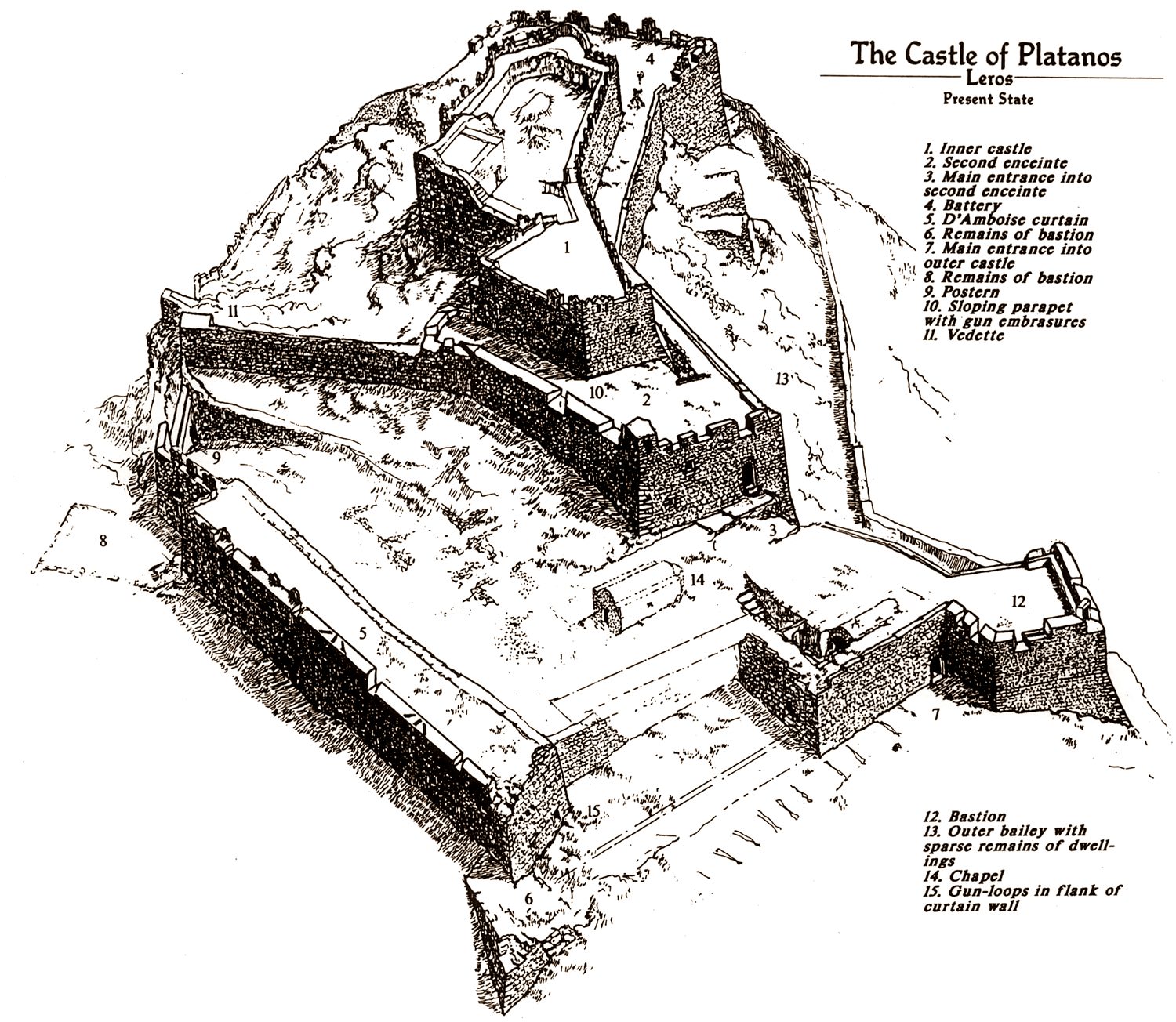
sketch by: Stephen C. Spiteri 1994; © Dr. Stephen C. Spiteri
History of the castle
Mt. Pitýki was already crowned by the acropolis of an ancient Greek town (cf. Ross 1843, p. 119; Benson 1963, p. 2; Coronelli/Parisotti, I, 1688).
In the early middle ages, Léros belonged to the Byzantine Empire. The acropolis became a Byzantine castle, whilst the island of Léros belonged to the Thema Sámos and later to the Thema Dodekánisos. In the year 1087 (or in 1088) the Byzantine emperor Alexios I. Comnenos – other sources mention his wife – offered one half of the castle, which belonged to the Byzantine Empire, to the Blessed Christodoulos, the founder of the famous monastery of St John at the neighbouring island of Pátmos, whose Metóchi it became (cf. M. Nistazopoulou-Pelekidou 1980, p. 58, after Stefanidou 2002, p. 252: “Our Queen, without being aware that there was another castle in Leros besides Pandeli, donated by the same chryssobul half of the castle of Pandeli to the honourable monk Hristodoulos and his monastery, and the other half to the residents of the island. When she was later informed of the existence of a second castle on Leros, which was called Lepida, she thought that it would not be right to have the monks share a castle with the inhabitants of the island, so she donated to Hristodoulos, his monastery and the monks under him the remaining half of the Pandeli castle, so that the whole castle together with the churches and the buildings in it would belong to the monks and their monastery in perpetuity. To the residents of Leros she gave the castle of Lepida to have as a shelter and not to obstruct the monks”).
As a consequence, the inhabitants were obliged to leave the castle and to move to another stronghold – the Palaiókastro, or castle of Lépida – on the southern side of the island (Loupou-Rokou 1999, p. 62).
In December 1326, after the Knights of St John had taken possession of Léros, Emperor Andronikos Palaiologos once more confirmed the possessions of the Patmian monastery of St John on Léros island (cf. F. Miklosich/J. Müller: Acta et diplomata graeca medii aevi et profana collecta ediderunt Frac. Miklosich et Jos. Müller, vol. VI. Vienna 1890, CVII, pp. 248ff).
At the end of the 13th century the brothers Moresco and their uncle Vignolo de Vignoli, Genoese citizens, had taken over the islands of Léros, Kós and Rhodes as a feud from the Byzantine Emperor, but they acted as if they were the owners of those islands. In 1306 Vignolo suggested to the Grandmaster of the Knights of St John, Foulques de Villaret, to conquer some of the Dodecanese Islands, which were part of the Byzantine Empire, conjointly with his troops. On May 27th, 1306, both of them signed a contract on the Island of Cyprus which settled the rights and the duties of both sides in case of a successful conquest: One third of the loot should become Vignolo’s property and Vignolo himself the governor of the conquered islands of Léros, Kós and Rhodes (cf. Adam Wienand: Der Orden auf Rhodos. In: Adam Wienand [Ed.]: Der Johanniter-Orden – Der Malteser-Orden. Der ritterliche Orden des hl. Johannes vom Spital zu Jerusalem. Seine Aufgaben, seine Geschichte. Köln 1970, pp. 144-193, here p. 149).
From 1314 to 1522 the island of Léros marked the northernmost outpost of the Hospitaller’s territory or Knight’s monastic state in the Aegean, which existed from 1307 till 1522. In 1319 the Knights were confronted with a rebellion on Léros, which had been incorporated into the administrative district of Kós. Inhabitants of Léros demanded to be returned to Byzantine rule; they revolted and killed members of the Hospitaller's garrison on the island (cf. Anthony Luttrell: The Hospitallers of Rhodes confront the Turks, 1306-1421. In: Anthony Luttrell: The Hospitallers of Rhodes and their Mediterranean World. Hampshire-Brookfield 1992, Chapter II, p. 84 [originally in: P. F. Gallagher (Ed.): Christians, Jews and Other Worlds: Patterns of Conflict and Accomodation (Lanham/USA, 1988), pp. 80-116]). But the Knight’s troops, however, had little trouble retaking the island.
From February 1386 to 1415 the islands of Léros, Kálymnos, and Kós were given as a feud by the Order of St John to the German Hospitaller Knight fra Hesso Schlegelholtz, the preceptor of the German commendatory in the town of Rottweil in Württemberg, who had to pay an annual rent of 100 fl for this (Bürchner 1898, pp. 39f).
In 1436 the knight fra Fantino Querini di Stampalia (from the Dodecanese island of Stampalia, nowadays called Astypálaia) became governor of the islands of Léros, Kálymnos and Nísyros (Mr. Michael Heslop gave me reference to Querini's term of office, who “did not become Governor of the three islands until 1436” by e-mail, 20th September 2009; Loupou-Rokou 1999, p. 62, denominated the year 1433). “This entailed the obligation to see to the maintenance and defence of the fortresses” (Loupou-Rokou 1999, p. 62).
As an Hospitaller outpost far away from the Order’s residence, the island of Rhodes, the island of Léros suffered from many Turkish incursions in the 2nd half of the 15th century and at the beginning of the 16th century: The island was sacked in 1455 and in 1457 (as the islands of Kós and Kálymnos were) and was left in an almost ruinous state (G. Bosio: Dell'Istoria della Sacra Religione et Illma. Militia di San Giovanni Gierosolomitano. 3 Volumes, Rome 1594; here Edition Rome, 1629, II, p. 260, cited after Spiteri 2001, p. 203).
Léros was attacked by enemy forces again in 1460 – this time its defenders could resist. Again in 1477 and in 1502 the island of Léros was invaded (Bosio, II, 1629, p. 257). “In 1439 and 1449 a visit of the Knights to the island is recorded, when they repaired old forts and erected new ones, with a further visit in 1453 for repairs to the castle of Leros, without specifying which one” (Stefanidou 2002, p. 250).
In 1492 the Hospitaller Knight fra Filippo had become the governor of Léros. Under his rule a strengthening of the Kástro‘s fortifications began. Possibly because of the very dangerous situation for the island of Léros and some more of the northern Dodecanese islands in those years the Chapter of the Knights of St John decided in 1495, to put the islands of Léros, Kálymnos and Kós under direct rule of the Order’s Grandmaster, the Frenchman Pierre d’Aubusson.
In May 1506 the Turkish corsair Camali (Spiteri 2001, p. 203, mentions him as “the notorious corsair Nichi”) besieged the castle. He had a fleet of eight galleys (Loupou-Rokou 1999, p. 67) which anchored in Pandéli Bay and Ajía Marína Bay. Because the castle was only manned by very few soldiers, Paolo Simeoni, the Hospitaller knight in command of the fortress, ordered the inhabitants of the village who had found refuge here, to wear “surcoats with the Order’s insignia and parade themselves on the ramparts” (Spiteri 2001, p. 203) to give the attackers the impression of a well manned and strongly defended fortification. So the Turks left Léros (Bosio 1629, II, pp. 587-589; Loupou-Rokou 1999, p. 67; Spiteri 2001, p. 203). With the fall of Rhodes after 1522 the island surrendered to the rule of the Ottoman sultan.
In 1648 the Venetian admiral Leonardo Foscolo attacked Léros with his fleet. His naval artillery bombarded the Kástro, and infantry under command of count Sabini attacked it; the Turkish commander surrendered and was said to have converted to christianity (Coronelli/Parisotti I, 1688, p. 349; Bürchner 1898, p. 41). The breach made by Foscolo’s troops in 1648 was only temporarily closed. Whether the destruction of two of the three bastions of the fortress happened during this siege remains unclear, as well as the origins and dates of a couple of cracked and rusted canons inside the fortress. Behind the destroyed large middle bastion the curtain wall was rebuilt (after 1648?) as a simple wall with a chemine de ronde just for the use of small firearms instead of canons, which means just for infantry, not for artillery defence.
There were changes and some new constructions in the castle’s interior during the period of the Turkish rule (1523-1912) as well as during the Italian rule (1912-43) (cf. Hellenic Ministry of Culture/Archeological Receipts Fund, Directorate of Protractions [Ed.]: Castrorum Circumnavigatio. 2001, p. 41).
The Kastro, owing to is commanding situation, was used by the Italian Army before and during World War II as an observation post for the heavily fortified Island of Léros and its important air defences. Look-out positions and living quarters were built inside the inner enceinte on the summit, “completely defacing the interior of the castle” (T. W. French: Losses and Survivals in the Dodecanese. In: Annual of the British School at Athens, XLIII, 1948, pp. 193-200, here p. 200, and plates 55-59). When the German Airforce bombed the island in November 1943, three bombs hit the castle’s walls near the main entrance. Just a small section of the outer enceinte was demolished, but in the outer courtyard the medieval St. Mary’s church (Panayia) was very heavily damaged but was repaired soon after, and outside the Kastro, “on the headland”, the chapel of Prophet Eliah was destroyed; “many ancient objects were said to have been destroyed when it was hit, but detailed information is not available” (French 1948, p. 200).
Till the beginning of the 21st century the Kástro hosted a Greek Garrison, because the Island of Léros is located close to the Turkish mainland. Nowadays all of the castle, which hosts a little museum, is open to the public. The castle was included in the Greek-Italian programme “Castrorum Circumnavigatio”, section of the programme which is integrated in “Interreg II Thrace-Aegean-Cyprus” and in “Interreg II Greece-Italy”.
Other Info
SourcesBürchner, Ludwig: Die Insel Leros (Wissenschaftliche Beilage zu dem Jahresbericht des Königlichen Theresien Gymnasiums in München für das Schuljahr 1897/98). München 1898.
Dawkins, R. M./Wace, Alan J. B.: Notes from the Sporades, Astypalaea, Telos, Nisyros, Leros. In: Annual of the British School at Athens, XII, 1905-06, pp. 151-174.
Δρελιώση-Ηρακλείδου, Α Μιχαηλίδου, Μ.: Λέρος. Από την Προϊστορία έως τον Μεσαίωνα, Athens 2006.
Gerola, Giuseppe: I monumenti medioevali delle 13 Sporadi. In: Annuario Scuola Arch. Atene II, 1916, pp. 61-67.
Ήσυχος , ΕΜ. Α.: Η Παναγιά του Κάστρου Ιστορία–Αρχαιολογία. In Έκδοση Ιεράς Μητροπόλεως Λέρου, Καλύμνου και Αστυπαλαίας, Α. Athens 1989, pp. 29-42.
Κουτελάκης, Χ.Μ.: Ιστορική και Αρχαιολογική Διερεύνηση του Ναού “Παναγιά του Κάστρου”, In Η Παναγιά του Kástroυ, ed. Ιεράς Μητροπόλεως Λέρου, Καλύμνου και Αστυπαλαίας (Athens, 1989), pp. 43-85.
Losse, Michael: Die Festung „Kástro tís Panajías“ bei Plátanos (Insel Léros), die früheste Bastionärbefestigung der Dodekanes?' In: fortifikation. Fachblatt des Studienkreises für Internationales Festungs-, Militär- und Schutzbauwesen e.V. (INTERFEST) 18, 2004, pp. 41-61.
Losse, Michael: The castle “Kástro tís Panajías” in the island of Léros (Greece), the first bastionated fortress in the Aegean?'. In: Europa Nostra Scientific Bulletin 62, 2008 (The bastionated fortresses in the age of Vauban, editor: Prof. G. Perbellini), pp. 91-100.
Losse, Michael: Die Kreuzritter von Rhodos - Bevor die Johanniter Malteser wurden. Ostfildern 2011.
Losse, Michael: The Development of Gunpowder Defences at the Knights Hospitallers' Fortifications on the Dodecanese Islands (1307-1522). In: Emanuel Buttigieg/Simon Phillips (Eds.): Islands and Millitary Orders, c. 1291-c. 1798. Ashgate Publishing Ltd. Surrey [England] 2013, pp. 189-200.
Losse, Michael: The development of Bastion in the Knights Hospitallers' Monastic State in the Dodecanese, Aegean Sea (15th and 16th centuries) – some new aspects / O Desenvolvimento dos Baluartes no Estado Monástico dos Cavaleiros Hospitalários no Dodecaneso, Mar Egeu (séc.s XV e XVI) – alguns novos aspectos. In: CEAMA 15, 2017 (Actas do Xº Seminário Internacional sobre Arquitectura Militar – 2016), pp. 216-234.
Losse, Michael: Die Burgen und Festungen des Johanniter-Ritterordens auf Rhódos und in der Ägäis (Griechenland) 1307-1522. (Publisher: Nünnerich-Asmus Verlag) Mainz 2017.
Loupou-Rokou, Athena Christina: The Aegean Fortresses and Castles. Athens 1999, pp. 62-67.
Paradissis, Alexander: Fortresses and Castles of Greece, vol. III: Fortresses and Castles of Greek Islands. Athens and Thessaloniki 1976, p. 148.
Ross, Ludwig: Reisen auf den griechischen Inseln Ägäischen Meeres. Zweiter Band. Enthaltend Andros, Syros, Mykonos, Amorgos, Astypaläa, Nisyros, Knidos, Kos, Kalymnos, Telendos, Leros, Patmos, Samos, Ikaros, DeIos, Rhenäa, Gyaros, Belbina. Stuttgart und Tübingen 1843.
Spiteri, Stephen C.: Fortresses of the Cross. Hospitaller Military Architecture (1136-1798). Valletta (Malta) 1994.
Spiteri, Stephen C.: Fortresses of the Knights. Ħamrun (Malta) 2001, pp. 198-203.
Stefanidou, Alexandra: Castles of the Knights Hospitallers. In: A. Triposkoufi/A. Tsitouri (Eds.): Venetians and Knights Hospitallers. Military Architecture Networks (ARCHI-MED Pilot Action) [Hellenic Ministry of Culture, Directorate of Byzantine & Postbyzantine Monuments], Athens 2002, pp. 184-253.
| First entry in Kastrologos: | August 2012 | Last update of info and text: | June 2021 | Last addition of photo/video: | June 2021 |
Sources
- Website ΟΔΥΣΣΕΥΣ - Greek Ministrty of Culture - Κάστρο Παντελίου (Greek only)
- Text and photographs 2, 10, 11 (2007) by Dr. Michael Losse
|
|
| Access |
|---|
| Approach to the monument: |
| Access to the castle is possible on a footpath (with a lot of steps) from Platanos, the main village of Leros, or otherwise by car from Platanos or Alinda. |
| Entrance: |
| Ticket entrance. Limited hours. |
| Timeline |
|---|
|




